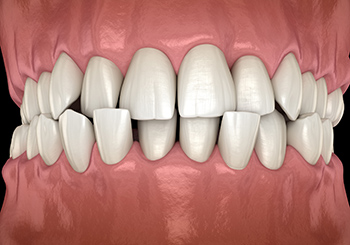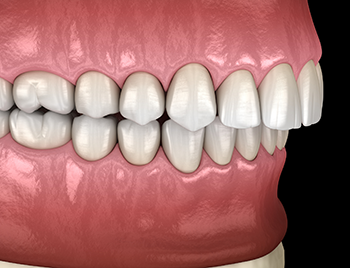
Research shows that nearly everyone has some level of malocclusion. Most of these are very mild and barely noticeable, so people just ignore it. However, some are severe enough to cause issues such as:

back teeth are aligned, front teeth overlap
upper teeth excessively overlap lower teeth
lower teeth overlap upper teeth
Dr. Jeremy Kurtz and the team at Invisalign Toronto have the experience and expertise to treat your malocclusion with Invisalign clear aligners. Dr. Kurtz has completed more than 4,000 Invisalign treatments. He has been granted the status of VIP Diamond and Top 1% Provider.
Dr. Kurtz has seen a variety of malocclusions during his career, including:
Crossbite is a condition in which some of the bottom teeth overlap the top teeth when the mouth is closed. This is considered a Class II malocclusion. This can be caused by habits such as thumb sucking in childhood, delayed eruption of permanent teeth, mouth breathing, and genetics.
This condition typically involves the front teeth, and can appear like a partial underbite. In addition, it may occur in conjunction with an underbite so that all of the bottom teeth are outside of the top teeth.


Overbite falls into the category of a Class II malocclusion. The teeth of the upper arch overlap the teeth of the bottom arch. When the patient's mouth is closed, the top teeth come straight down, covering a portion of the bottom teeth. If left untreated, an overbite can lead to breathing problems, oral health issues, and jaw disorders.
An underbite is a condition in which the teeth of the lower arch fall in front of the teeth of the upper arch. This is a Class III malocclusion and can be a skeletal or a dental condition.
If skeletal, the bones of the jaw will be involved, with one of the jaws being underdeveloped. If this is the case, you may need more than teeth straightening, depending on the severity.
In some cases, an underbite only affects the teeth and may occur alone or in conjunction with a crossbite. Like the other malocclusions, it's important to treat underbite early to prevent complications in the future.

Traditional metal braces have been proven an effective method for straightening teeth. In fact, for many years, this was the primary method for treating malocclusion. This treatment involves metal brackets on each tooth with an archwire connecting them. The wire puts pressure on the affected teeth, gradually moving them to their appropriate position in the jaw.
Treatment time varies based on the type and severity of your malocclusion, but typically takes at least 18 months and may take as much as 36 months. The cost of metal braces ranges from about $2,000 to $6,000. The good news is, most dental plans will cover treatment with metal braces.


Invisalign clear aligners were introduced in the late 1990s by an orthodontic patient who wanted to find a better way to treat malocclusions. Invisalign is a series of custom, clear aligners that are changed out every 1 to 3 weeks based on your personal treatment plan and your progress. You should wear the aligners for 20 to 22 hours a day for best results.
These aligners place even pressure on your teeth to gradually shift them into their appropriate position within your mouth. They are custom-made based on your current condition and expected progress.
Invisalign has been proven effective in the treatment of most mild to moderate malocclusions, including gapped teeth, crowded teeth, overbites, underbites, crossbites, overjets, and crossbites. This treatment may also be appropriate for more severe cases when used in conjunction with attachments. However, in extremely severe cases, including rotated teeth, traditional braces may be the better option.
Treatment time varies from one patient to another, but typically ranges from about 12 to 18 months for most mild to moderate cases. Patients with very mild cases of malocclusion may see results in about 6 months, while more severe cases may take up to 24 months.
Following treatment, you will be given a retainer to wear to keep the teeth in their proper position. At first, the retainer will be worn like the aligners- but over time, the time required will be reduced until it is only required at night.
The cost of Invisalign treatment depends on the type and severity of your malocclusion, which dictates how many aligners you need. Treatment starts at approximately $1,500 and goes up to $8,000. This is comparable to the cost of traditional metal braces. Some dental insurance plans will cover Invisalign, while others consider it cosmetic.
Our office staff will work with your provider to determine coverage. We also offer several financing options to help you pay for treatment.
Most people prefer to treat their malocclusion with Invisalign because the aligners are virtually invisible. Plus, treatment is much more convenient and require as much time in the dental chair as traditional braces.
Children should be evaluated for malocclusion starting at about the age of 7. In some cases, problems can be corrected early, reducing the orthodontic treatment in the future. However, if orthodontic treatment becomes necessary, it will typically begin around age 10 to 14, after most of the primary teeth have fallen out and the permanent teeth have come in.
There is no upper age limit for teeth straightening procedures. You can work with your dental provider to determine if you could benefit from teeth straightening.
The length of treatment for teeth straightening depends on the type and severity of the malocclusion. Typically, traditional braces take about 24 to 36 months. However, patients with mild malocclusion may see results in as little as 12 months.
Invisalign typically works a little faster, with most patients seeing results in 12 to 18 months. Patients with very mild malocclusion may see results within 6 months, while patients with more severe malocclusion may require up to 24 months of treatment.
There are several benefits associated with teeth straightening, including:
When your teeth are too crowded or too spread apart, bacteria can settle between teeth causing gums to become red and inflamed. This is one of the first signs of gum disease.
However, when teeth are straight, you don't have to work as hard to keep them clean.
Straight teeth are much better for chewing, which is the beginning of the digestion process. When food that has been chewed poorly reaches your stomach, it makes your digestive system work harder, which means you do not get the nutrients from the food and you may have stomach issues. However, chewing your food more thoroughly improves digestion.
Even if you stick to a healthy diet, when you are unable to chew your food properly, you can end up with an unhealthy gut.
When your teeth are misaligned, it can also cause the jaw to become misaligned, putting pressure on your jawbone and gums. This results in head and neck pain. However, straightening your teeth will allow your bite to work properly which means that you will experience less pain and find it easier to chew your food.
Misaligned teeth are more likely to crack or break if you experience trauma. In addition, the inability to properly care for your teeth weakens them, making them more susceptible to breakage. Straighter teeth are less likely to be damaged.
Your teeth have a major impact on your speech. If they are misaligned, it can negatively impact your ability to speak clearly. However, straight teeth allow you to speak clearly and properly pronounce words, which may also improve your self-confidence.
Research shows that it is more aesthetically pleasing to have straight teeth than to have crooked teeth. Orthodontic treatment can move your teeth into their appropriate position within the jaw, improving your appearance.
All of the above benefits of straightening teeth ultimately lead to overall better health.
If you have a malocclusion and believe that you might benefit from treatment with Invisalign clear aligners, schedule your consultation with Dr. Kurtz and the team at Invisalign Toronto. We have two conveniently located offices to serve you and can even do a video conference consultation if that is easier.
Dr. Kurtz and his staff understand that you may have some questions and concerns when it comes to treating your malocclusion. We are happy to discuss these with you at any time. Below are some of the most common questions that we hear:
There are some malocclusions that can be resolved without braces, including:
extractions or a retainer may be used to resolve overcrowding
typically requires headgear or an Herbst appliance, which are not discrete and take a year or more to work
a palatal expander can be used to widen the upper arch to create space for teeth. While fairly invisible, this device can cause discomfort when adjusted
The cost of teeth straightening depends on the method of treatment that you choose.
Traditional braces cost an average of $2,000 to $6,000, while Invisalign clear aligners cost an average of $1,500 to $8,000. Dental insurance will typically cover a portion of the cost of traditional braces. Many will also cover Invisalign, while others classify this as a cosmetic treatment. Our office staff will work with your provider to determine coverage.
"*" indicates required fields